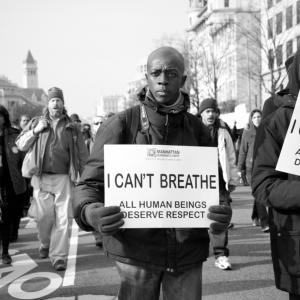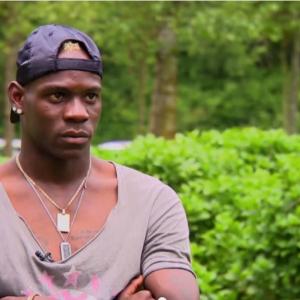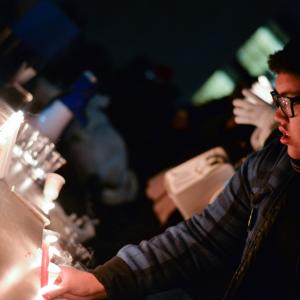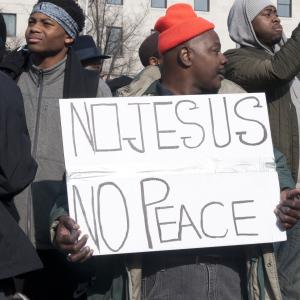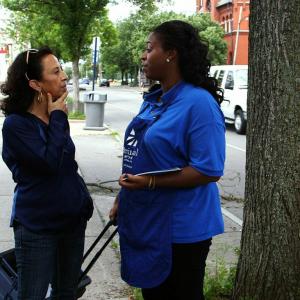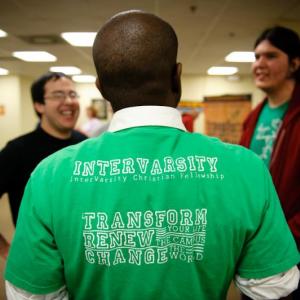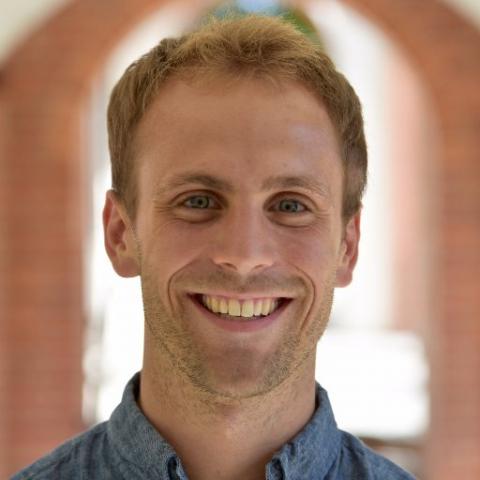
Ryan Stewart is a teacher in Springfield, Mass., and graduate of Yale Divinity School. You can find him on Twitter @RyanMcStew.
Posts By This Author
Considering Nonviolence in Baltimore
Recent protests in Baltimore are raising the question of (non)violence anew. Should violent protesters be criticized? Should Christians call for nonviolence?
Some bluster “Of course!” while others say that’s not the point.
Over at The Atlantic, Ta-Nehisi Coates, who grew up in Baltimore, is challenging calls for nonviolence in an article entitled “Nonviolence as Compliance.” Calling “well-intended pleas” for nonviolence “the right answer to the wrong question,” Coates writes:
When nonviolence is preached as an attempt to evade the repercussions of political brutality, it betrays itself. When nonviolence begins halfway through the war with the aggressor calling time out, it exposes itself as a ruse. When nonviolence is preached by the representatives of the state, while the state doles out heaps of violence to its citizens, it reveals itself to be a con. And none of this can mean that rioting or violence is "correct" or "wise," any more than a forest fire can be "correct" or "wise."
The line bears repeating: “When nonviolence begins halfway through the war with the aggressor calling time out, it exposes itself as a ruse.” Are newly scared white folks simply “calling timeout?”
Coates wants to ground our conversation about violence in the narrative of a larger “war.” For him, violence did not “break out” last night – violence has always been present. Coates wants to shift our focus from the shorter story of rock-throwers to the much longer story of the black experience in the United States.
As the clergy marching in Baltimore put it, “There’s been a state of emergency way before tonight.”
Whose Fear? Which Newsfeed?
In “A Newsfeed of Fear” (Sojourners, May 2015), Gareth Higgins argues that our newsfeeds often scare us into believing the world is getting worse when the world is actually getting better.
Although I resonate with a call for calm in an age of violent clickbait, we cannot discuss “A Newsfeed of Fear” without talking about race in post-Ferguson America. When we say our newsfeeds are filled with fear, we need to think more about which newsfeeds are making us afraid and whose fear we’re discussing.
For example, when Higgins bemoans “horrifying, brutal videos, edited for maximum sinister impact,” perhaps a reference to the all-too-familiar videos of ISIS hostages, I actually envision Walter Scott and Eric Garner and Tamir Rice and all the others. While the videos produced by ISIS are fearmongering propaganda intended to provoke, we wouldn’t want to call newsfeeds unmasking the reality of police brutality a corrupting influence on our society, right?
And in this context Higgins’ claim that the world is actually getting better is especially dangerous. Advising police brutality whistle blowers to keep their violent videos to themselves because they paint “too cynical a portrait of the improved race-relations in our society” would border on the insane.
The problem with media is not so much that it makes us fearful, but that it makes certain people fear certainthings and certain other kinds of people. It makes my mom fear that her granddaughters will get kidnapped in a very safe neighborhood. It makes me, a white guy, fear walking past black men in hoodies at night, and not white guys in polos. What you fear depends on where you’re standing and what you’re watching.
From where Higgins is standing, “our culture has been hoodwinked by the idea that we’re living in the center of crisis, when actually we’re in the midst of the evolution of hope.” In his eyes, our culture cultivates a false sense of constant terror.
But we need to ask: whose culture? When I read #BlackLivesMatter activists, they seem to say: “no, most people have been hoodwinked by the idea that ‘our’ (meaning American) culture is living in the midst of the evolution of hope, when actually ‘a certain (black) culture’ is indeed in the center of crisis.” So who’s right about the value of violent, fearful newsfeeds?
It depends on where you’re standing and what you’re watching.
WATCH: A Brief History of Overt Racism in Professional Soccer
When fans barred a black man from boarding a train as they chanted racist lyrics after the Chelsea vs. PSG match on Feb. 17, it was only the most recent in a long history of similarly egregious acts.
Professional soccer is no stranger to racism. While such acts of overt bias should anger us, they should not surprise us. Whether it's chanted slurs, especially dirty tackles, or thrown bananas, racist behaviors emerge from a racist culture.
Below are videos of six of the most infamous incidents of racism in professional soccer since 2011. It is important to remember that these acts are only the explicit tip of an implicit iceberg. These are only some of the examples captured on video.
What Makes a Christian Argument?
In his famous passage on love, Paul shifts our attention from the what to the how:
"If I speak in the tongues of mortals and of angels, but do not have love, I am a noisy gong or a clanging cymbal. And if I have prophetic powers, and understand all mysteries and all knowledge, and if I have all faith, so as to remove mountains, but do not have love, I am nothing. If I give away all my possessions, and if I hand over my body so that I may boast, but have not love, I gain nothing."
He’s not talking about the content of our arguments. He’s talking about the process. For Paul, it is not enough that we do “Christian” sorts of actions, no matter how great they are. We must act in a Christian style — with love.
Christian arguments, then, should reflect this style. They should be patient and kind. They should not be boastful or arrogant or rude.
But the reality of our Scriptures and the reality of our God is that love can — and in some cases, should — be tough. This love sees that there must be space for righteous anger. It recognizes that patience can too easily become a luxury for the privileged. We believe in a God who gets angry on behalf of those he loves. We believe in a Jesus who overturns tables in the temple courts.
The problem is that most readers of this article will applaud at either the thought of a kind, patient argument or at the thought of a tough, angry argument. The trick is to deeply desire both.
#ReclaimMLK Protests Call For A 'Year of Resistance’
Over Martin Luther King Jr. Day weekend, protesters across the country sought to reclaim the radical, activist legacy of Dr. King by taking to the streets in protest of ongoing police brutality. Frustrated that his work has too often been softened and sanitized, protesters stressed that Dr. King’s original tactics, which were often direct and controversial, are desperately needed today if the United States is to effect lasting change.
“[Dr. King] has become more of a vague idea and people forget that he was a person that marched the streets,” one protester in Washington D.C., Caroline, said.
“They need to be talking about real activism and real change and not just having a day off work and saying the name.”
Another woman, Janelle, described Dr. King as “a great leader but also part of a larger movement that is still trying to combat the same injustices that he was fighting against.”
Marching with three children under the age of ten, Janelle explained their presence bluntly.
“This problem isn’t going to go away,” she said.
Can the Church Offer More than Candlelight Vigils for Justice?
What can local churches do to support ongoing protests against, and indeed upheaval of, an unjust criminal justice system and deep-seated white supremacy? In a season that Lisa Sharon Harper recently described as “Advent as protest,” what might it mean for Christians to anticipate the coming of Christ by physically challenging oppression? For pastors all over the United States, these are the questions of the moment.
In Washington, D.C., local faith communities sought to live into the vision of Advent as protest by holding a “vigil for justice.” Although this vigil beautifully documented the capacity of the local church to advocate for justice, the way local media framed the vigil forces communities of faith to think more deeply about their understanding of solidarity.
Spread out along nearly 6.5 miles of 16th Street, hundreds of people held candles and signs in support of recent protests against racial injustice. As people passionately waved their signs or held their heads down in prayerful lament, passing cars and buses slowed to honk in support. Catching on with the theme of Advent, attendees hoped to shine light in the darkness not only to create awareness and show solidarity, but also to testify to the hope of faith.
Cecilia Choi, a member of District Church explained, “This is the time of Advent when God came and he started his work of reconciliation with us by becoming one of us. And I think it’s perfect to come out and work on reconciliation and joining with our black brothers and sisters. They’re not just our neighbors, they’re our brothers and sisters in Christ. We have such an obligation to them. I think this is an act of worship.”
When asked why she was on the streets, one woman responded, “Well, what do I say? [Laughs.] That’s the meaning of our faith! To be one with people who are suffering.” Another man called racism “the deepest sin in the United States.”
Such descriptions of the vigil reach to the core of the church’s mission to “do justice, love mercy, and walk humbly.” Here are churches standing in solidarity with those suffering at the hands of racist oppression as an “act of worship.” Here are churches bringing their resources of prayer, lament, and peace into the public sphere, challenging observers to wrestle with God’s call to justice. Yet, though the event was beautiful, the way it was framed by local media raises tough questions for churches. Contrasting this demonstration with other recent protests, one reporter said, “This protest was in contrast to many of the protests we’ve seen over the past few weeks, with groups blocking traffic and loudly chanting. This group was quiet and purposeful.”
'Some Folks Just Woke Up:' Families of Victims of Police Brutality Join 'Justice for All' March in Washington, D.C.
“Excuse my ignorance, I thought I was a free black man.”
“I’m 11 [years old], I matter.”
“You can choose to look away, but never again can you say you didn’t know.”
“How many times do we have to protest the same [s**t]?”
“White silence is white violence.”
“We have nothing to lose but our chains.”
These signs, and many others, lined the horizon of Pennsylvania Avenue on Saturday in Washington, D.C. In a ‘Justice for All’ march organized by Al Sharpton and the National Action Network, thousands of protesters gathered to protest police actions that have resulted in the deaths of unarmed young black men across the United States.
After marching from Freedom Plaza to the U.S. Capitol, protesters listened to speakers from national racial justice organizations address some of these most recent acts of police brutality.
Al Sharpton sought to draw attention to the diversity present on the streets.
“This is not a black march or a white march. This is an American march for American rights,” he said.
Indeed, the black community was not alone in speaking up against police brutality. One Latina activist encouraged her Latino brothers and sisters to “voice their pain” from police harassment and “come forth and unify with the African American community so we can be strong together.”
“¡Ya Basta!” she concluded. [“Enough is enough!”]
What Good Is Christian Faith to Contemporary Protesters?
As I followed protesters along the National Mall after the non-indictment of New York City police officer Daniel Pantaleo, I was particularly struck by the comments of one black gentleman named Houston. Putting down a sign that said “Boycott Christmas,” he took a speaker, called for quiet, and, in the midst of the crowd, began to preach:
“We must move on to that new day in which justice will roll down like water, and righteousness like a mighty stream. It is time for black and whites to take hand and hand and move this nation beyond the pitiful historical dilemma … So black and white together, we must move on to where even the stones will shout out, ‘It’s time for America to be one.’”
“Amen,” someone shouted.
Amen, indeed.
Drawing on Amos 5:24 and Luke 19:40, Houston had brought the riches of a deep biblical tradition to bear on our contemporary political struggle. Like the early Christians, he called not only for justice but also for reconciliation between races. His faith had inspired him to act.
Or so I thought.
D.C. Protesters Confront Police, Christmas Season in March for Racial Justice
Protests have again erupted across the United States following the Staten Island grand jury’s decision not to indict Daniel Pantaleo for the choking and killing of Eric Garner. Building off the online mobilizing network established in response to Ferguson, the most recent wave of community actions have gathered support via social media. After events are posted on Facebook or Tumblr, or simply spread through word of mouth, Twitter hashtags provide real-time updates that direct potential supporters to the location of a march.
In Washington, D.C., protests began outside the Department of Justice at 4:00 p.m. and continued throughout the city late into the night — through the National Mall, near the White House, the D.C. police department, and city hall. Comprising many races and many ages, crowds chanted phrases like, “Black lives matter” and “This is what democracy looks like.” One black mother, Shantelle, who was pushing her toddler in a stroller, explained why she was out marching today:
“We’re proud to be American. We’re military. We love our country. But we keep getting it, my son is gonna’ keep getting it. We’re not valued and we’re not looked at. I want him to grow up in a place where he doesn’t have to worry he wore the wrong hoodie, or he was playing with a toy gun, or he gets a chokehold, and dies.”
Another, older woman simply said, “I’m old. I hate that I have to be out here. I’m sick of doin’ the same old stuff.”
Can 'Good Will Hunting' Help You Decide What to Do with Your Life?
It probably can’t. It may help you ponder the kind of person you hope to become, and it might even help you orient yourself towards the next few baby steps you take in this life, but decide what you want to do with your life? Not likely. None of us ever really decides ‘what to do with our lives,’ as if that were some golden tablet plucked out of the heavens. But that won’t stop us from frantically stressing.
As a recent college graduate who does indeed stress about such a question, I recently rediscovered the modern classic that is Good Will Hunting as I spent Thanksgiving anxiously deliberating my future — and realized it has a lot to offer.
Although the film is perhaps most famous for pulling heart strings, it is also a deep exploration of courage and humility. It forces viewers to question their vocational priorities and even invites reflection upon why we choose to seek, or avoid, outward success. If you haven’t seen this 1997 drama, and you’re stressed about what to do with your life, you should stop reading now and go watch it before I start dropping spoilers.
Elevating Our Cultural Competency: A Q&A with NPR’s Maria Hinojosa
“Behind every number, there’s a story.”
That’s what inspires Maria Hinojosa, host and executive producer of NPR’s Latino USA, to investigate the dramatic demographic changes taking place in the United States in her new PBS show, America by the Numbers. In a nation that will be majority non-white by 2043, Hinojosa’s storytelling focuses largely on the oft neglected experiences of immigrants and people of color.
Unafraid of what mainstream media too often neglects, Hinojosa’s America by the Numbers brings to life the tensions at the heart of a rapidly diversifying America. She examines not only the unjust treatment of underrepresented communities by the American government but also the cultural conflicts inherent within these communities. For Hinojosa, the conflicts between tradition and progress, community and individuality, white and non-white are not to be avoided, but rather spotlighted.
Last week, Sojourners chatted with Hinojosa about America by the Numbers and the role the media can play in welcoming these demographic changes. This conversation has been lightly edited for length and clarity.
Who Cares About Guam? On American Patriotism and Veteran Mental Health
In ‘Island of Warriors,’ the second episode of the new PBS series America by the Numbers, Maria Hinojosa, executive producer and anchor of NPR’s Latino USA, examines the challenges faced by American veterans in Guam. While Guamanian residents serve in the military at three times the rate of the rest of the United States and territories, they receive the lowest per capita medical spending from the U.S. Department of Veteran Affairs. This discrepancy in resources translates to only two full-time psychiatrists for an island of as many as 16,000 veterans — 3,000 of whom are actively requesting VA medical support for psychological disorders like PTSD.
How could this be possible?
Like Puerto Rico, Guam is a U.S. territory. While residents of these territories can, and do, enlist in the American military, they cannot vote for the president who sends them into battle. Similarly, they are represented on the floor of the House of Representatives only by delegates, who have no voting power. Eddie Calvo, the Republican governor of Guam, spoke truthfully when he ventured to call Guam a “colony” of the United States.
This disenfranchised status means that residents of U.S. territories like Guam have no real standing in American democracy. They must rely on others to advocate for them. When every state could use more resources to take care of the nearly 20 percent of veterans returning from Iraq with PTSD, who’s going to stand up for Guam?
As far as geopolitical power, Guam truly is the “least of these” in American democracy. While many Americans deplore Puerto Rico’s secondary status in American political discourse, Hinojosa recalled one Guamanian saying, “We just wish we were Puerto Rico. At least then people would know where we are.”
Think about it: Do you know where Guam is? I didn’t.
What Does It Really Mean to ‘Believe?'
Last week, InterVarsity Christian Fellowship was derecognized at California state schools, barring the group’s access to on-campus meeting rooms, school funds, and other student functions. While InterVarsity welcomes all to participate in its campus-based student groups, it was derecognized because their leadership policy, which requires students in positions of leadership to sign a statement of belief, conflicted with state-mandated nondiscrimination policies.
From the standpoint of religious liberty in this secular age, it’s hard to get around the troubling nature of this policy. Part of me squirms and rolls my eyes at the increasing irony of the intolerance of tolerance. Why can’t we — as a religious community born of a 2,000-year-old tradition — retain some beliefs that have become out-of-style in the modern academy? The principle irks me: Shouldn’t Christian groups be allowed to require that their leaders are Christian?
On the other hand, might this be another example of evangelicalism prioritizing doctrines over compassionate love of the world? I mean, can’t InterVarsity recognize why nondiscrimination policies exist, stop complaining about persecution, welcome their LGBTQ members into leadership, and get on to the real business of redeeming creation to the glory of God? Is this yet another haunting specter of fundamentalism clinging to its evangelical host?
Given that the crux of this issue revolves around what InterVarsity’s student leaders ostensibly do or do not believe, perhaps this is an opportunity for Christians to (re)consider their affinity for “belief statements.” Are they really that important?
Now, wait — before you throw your hands up and shout “liberal postmodern relativism,” let me explain.
Drawing on sociologist Pierre Bourdieu, Christian philosopher James K.A. Smith writes in Imagining the Kingdom that belief is not primarily “assent to propositions but rather a functional, enacted trust and entrustment to a context and a world.”
In other words, it is not primarily our intellectual assent to a correct doctrine that constitutes belief. To our enlightened modern minds, this may sound frightening. What we think doesn’t matter? Aren’t propositional belief statements the very bulwark which has preserved Christian orthodoxy against centuries of secular onslaught?
But consider: what does it really mean to believe in something?

